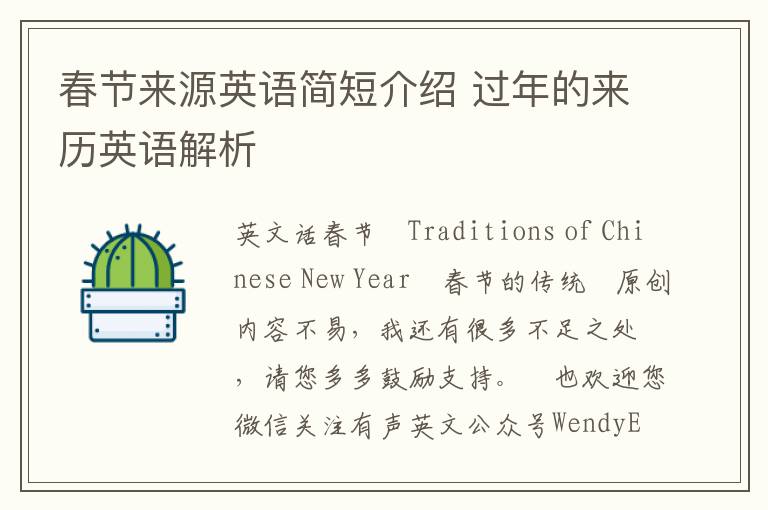
英文话春节
Traditions of Chinese New Year
春节的传统
原创内容不易,我还有很多不足之处,请您多多鼓励支持。
也欢迎您微信关注有声英文公众号WendyEnglishTimes,
免费收听本期音频及往期新闻,体育及娱乐内容。
本期音频:英文话春节-Traditions of Chinese New Year-春节的传统
The Chinese New Year was traditionally a time to honor deities as well as ancestors.The evening preceding the New Year‘s Day is frequently regarded as an occasion for Chinese families to gather for the annual reunion dinner. It is also traditional for every family to thoroughly clean their house, in order to sweep away any ill fortune and to make way for incoming good luck. Another custom is the decoration of windows and doors with red paper-cuts and couplets. Popular themes among these paper-cuts and couplets include good fortune or happiness, wealth, and longevity. Other activities include lighting firecrackers and giving money in red paper envelopes.
中国新年传统上是一个祭祀神灵和祖先的时间。新年的前一天晚上,中国家庭通常会聚在一起吃年夜饭。对每个家庭来说,大扫除也是一种传统,以扫除任何厄运,迎接即将到来的好运。另一个习俗是用红色的剪纸和对联装饰门窗。这些剪纸和对联中流行的主题包括好运或幸福,财富和长寿。其他活动包括放鞭炮和送红包。
Chinese New Year‘s Eve 除夕
The day before the Chinese New Year usually accompanied with a dinner feast, consisting of special meats are served at the tables, as a main course for the dinner and as a offering for the New Year.
中国新年的前一天通常会有一顿年夜饭,一些特别的肉食会摆在桌上,作为晚餐的主菜和新年的祭品。
In northern China, it is customary to make dumplings to eat around midnight. Dumplings symbolize wealth because their shape resembles a Chinese sycee. In contrast, in the South, it is customary to make a glutinous new year cake and send pieces of it as gifts to relatives and friends in the coming days. It has the meaning of "increasingly prosperous year in year out".
在中国北方,人们习惯在午夜前后吃饺子。饺子象征着财富,因为它们的形状像中国的银锭。与此不同的是,在南方,人们的习俗是制作糯米糕,并在接下来的日子里把它作为礼物送给亲戚和朋友。它有“繁荣昌盛年复一年”的意思。
After dinner, some families may visit local temples hours before midnight to pray for success by lighting the first incense of the year; however in modern practice, many households held parties to celebrate. Traditionally, firecrackers were lit to ward evil spirits. A tradition of staying up late on Chinese New Year‘s Eve is known as shousui, which is still practised as it is thought to add on to one‘s parents‘ longevity.
晚饭后,一些家庭可能会在午夜前几个小时参拜当地寺庙,点燃今年的第一柱香,祈求成功; 然而,现如今,许多家庭也会举行聚会来庆祝。传统上,人们燃放鞭炮是为了驱赶邪灵。除夕夜熬夜的传统被称为“守岁”,这被认为是延长父母寿命的一种习俗。
Traditional food 传统食品
A reunion dinner is held on New Year‘s Eve during which family members gather for a celebration. The venue will usually be in or near the home of the most senior member of the family. The New Year‘s Eve dinner is very large and sumptuous and traditionally includes dishes of meat (namely, pork and chicken) and fish. Most reunion dinners also feature a hot pot as it is believed to signify the coming together of the family members for the meal. In most areas, fish is included, but not eaten completely, as the Chinese phrase "may there be surpluses every year" sounds the same as "let there be fish every year."
除夕夜,一家人会聚在一起吃团圆饭。聚会地点通常在家中或家庭中最年长成员家的附近。除夕夜的晚餐是非常丰盛的,传统上包括肉(即猪肉和鸡肉)和鱼。大多数团圆饭也有火锅,因为象征着家庭成员团聚在一起。在大多数地区,鱼是要有的,但不全吃完,因为这听起来像是中国的成语“年年有余”。
Other traditional foods consists of noodles, fruits, dumplings, spring rolls, and sweet rice balls. Each dish served during Chinese New Year represents something special. The noodles symbolize the wish for a long life. The fruits that are typically selected would be oranges, tangerines, and pomelos as they are round and "golden" color symbolizing fullness and wealth. Their lucky sound when spoken also brings good luck and fortune. Dumplings and spring rolls symbolize wealth, whereas sweet rice balls symbolize family togetherness.
其他的传统食物包括面条、水果、饺子、春卷和汤圆。中国新年的每道菜都代表着一些特别含义。面条象征着长寿。人们通常会选择橙子、橘子和柚子,因为它们圆圆的而且黄灿灿的,象征着丰盛和财富。它们读起来的声音也会带来好运和机遇。饺子和春卷象征着财富,而汤圆象征着家庭团聚。
Red packets are sometimes distributed during the reunion dinner. These packets contain money that reflects good luck.
红包有时会在团圆饭期间分发。这些包里装的钱预示着好运。
Clothing 衣着
The color red is commonly worn throughout Chinese New Year; traditional beliefs held that red could scare away evil spirits and bad fortune. The wearing of new clothes is another clothing custom during the festival, the new clothes symbolize a new beginning in the year.
红色通常是整个春节穿的颜色;传统上认为红色可以吓走恶灵和厄运。穿新衣是节日期间的另一个服装习俗,新衣服象征着新一年的开始。
Now that you have learned the traditions of this Festival, I hope you could benefit from it and wish you a happy Chinese New Year!
现在你已经了解了这个节日的传统,我希望你能从中受益,并祝你春节快乐!